The Power of Song: Students Learn English Through Music and Motion
For thousands of years songs have been used to educate peoples of all cultures. The video to the right demonstrates the power that music has to help us make meaningful connections to new content. In the 21st century music is easier than ever before to generate, share, and collect. This means that we have opportunities to use music in ways that haven't traditionally been possible or, at least, easy.
TECHNOLOGY and MUSIC
With the advent of the ipod and other portable devices music has become an integral part of most of our students' lives. TV shows and movies popularized by todays students are likewise music oriented. By incorporating music into the classroom we can potentially increase motivation, enhance lessons, access aural learning modalities, and even use it to aid in classroom management. Below I have detailed my own use of digital music technology to enhance my students curriculum and make our day smoother. By creating folders of music, which I can access with the click of a button, I have the ability to provide my students with a rich and varied connection to music all day long.
Just Another Day In The Classroom
8:10am - Beethoven's 5th Symphony The students enter the classroom to a soft melody playing in the background. They reflect on the previous day and compose a journal entry while feeling calm and inspired. There is some research that suggests that music can help students to stimulate the dendrites in the brain, thereby increasing creativity and even improving metacognition. We also listen to classical music during some testing as it helps students focus by providing a block to spontaneous background noise.
8:35am - "Inner Yogi" Musical chimes signal students to transition to the carpet for circle time. They are so calm at this time of the morning that this music fits our mood. For every piece of music students have determined the expectation for behavior during the playing and we have practiced at the begining of the year the steps we will take.
9:00 - Theme to "Zorro" Students gather their math books and materials, and go to their centers. Transitions are always quiet and students are motivated to move efficiently to the music.
9:05 - "Fraction Action" by Ron Brown Some centers will have math music that students can read, listen to, and sing. Most educational research agrees that memorization of facts does contribute to student success in mathematics, as a small part of student learning. This being the case, music is a great mnemonic device, and many children will appreceate musical memorization more than traditional drill and kill. Accompanied by movement, song becomes even more motivating and memory enhancing.
10:00 - "We Are Gonna be Friends" by White Stripes
When students hear this song they know that it is time to transition to recess. Students pick up their materials and any mess while the song plays and then wait quietly until the class manager dismisses them. I chose this song because it sends a message that they will be going out to make lasting friendships.
10:30 - "Homophones" by Ron Brown Just as during Math centers we may begin our Language Arts period with a song that will highlight or review content. Students love it and sometimes, during testing, there will be a few students quietly humming to remember a term or definition.
11:50 - "Eat It" by "Weird" Al Yankovich Time to clean up for lunch! I get a variety of food songs from http://www.mixedup.com/foodsongs.htm. Who new?
12:35 - "I'm Just a Bill" by Schoolhouse Rock We're learning about government in Social Science and there are many great songs to help with this purpose. However, it is not enough to simply play the songs. For students to create meaning with non-repetitive music they must connect to the words and discuss what they mean. So, we always read and discuss lyrics before including a song into our daily regimen. By the way, it is amazing how many students don't know what the pledge of allegiance is for or what it means and they say it every day - travesty!
1:15 - "Matter Song" by our class (Listen Below) Though there are many great science content themed songs, we chose to make our song this week. We did this by brainstorming all the things we've been learning about matter, putting it together in a written poem form, and settting it to the tune of "She's Coming Around the Mountain". We do this in the other content areas as well from time to time. Look below to find tips on creating music with your students.
2:00 - The "A Train" by Lois Armstrong
For art this week we are studying collage, which has a very jazzy feel. So, while we work on our art we listen to jazz for inspiration. This also helps us to stay focused on our work.
2:35 - "This Little Light of Mine" by Harry Dixon Loes, sung A cappella As we get cleaned up and ready to head home we've been singing this song to remind us of how strong we are in the world. This is also free music time, when students are encouraged to bring their favorite music to school and we'll listen and discuss it as we get ready to finish our day.
With the new digital music technology, each song can be chosen and downloaded seperately, music can be organized into folders, and a variety of songs can be used for each content area so as to keep the music exciting and fresh.
8:10am - Beethoven's 5th Symphony The students enter the classroom to a soft melody playing in the background. They reflect on the previous day and compose a journal entry while feeling calm and inspired. There is some research that suggests that music can help students to stimulate the dendrites in the brain, thereby increasing creativity and even improving metacognition. We also listen to classical music during some testing as it helps students focus by providing a block to spontaneous background noise.
8:35am - "Inner Yogi" Musical chimes signal students to transition to the carpet for circle time. They are so calm at this time of the morning that this music fits our mood. For every piece of music students have determined the expectation for behavior during the playing and we have practiced at the begining of the year the steps we will take.
9:00 - Theme to "Zorro" Students gather their math books and materials, and go to their centers. Transitions are always quiet and students are motivated to move efficiently to the music.
9:05 - "Fraction Action" by Ron Brown Some centers will have math music that students can read, listen to, and sing. Most educational research agrees that memorization of facts does contribute to student success in mathematics, as a small part of student learning. This being the case, music is a great mnemonic device, and many children will appreceate musical memorization more than traditional drill and kill. Accompanied by movement, song becomes even more motivating and memory enhancing.
10:00 - "We Are Gonna be Friends" by White Stripes
When students hear this song they know that it is time to transition to recess. Students pick up their materials and any mess while the song plays and then wait quietly until the class manager dismisses them. I chose this song because it sends a message that they will be going out to make lasting friendships.
10:30 - "Homophones" by Ron Brown Just as during Math centers we may begin our Language Arts period with a song that will highlight or review content. Students love it and sometimes, during testing, there will be a few students quietly humming to remember a term or definition.
11:50 - "Eat It" by "Weird" Al Yankovich Time to clean up for lunch! I get a variety of food songs from http://www.mixedup.com/foodsongs.htm. Who new?
12:35 - "I'm Just a Bill" by Schoolhouse Rock We're learning about government in Social Science and there are many great songs to help with this purpose. However, it is not enough to simply play the songs. For students to create meaning with non-repetitive music they must connect to the words and discuss what they mean. So, we always read and discuss lyrics before including a song into our daily regimen. By the way, it is amazing how many students don't know what the pledge of allegiance is for or what it means and they say it every day - travesty!
1:15 - "Matter Song" by our class (Listen Below) Though there are many great science content themed songs, we chose to make our song this week. We did this by brainstorming all the things we've been learning about matter, putting it together in a written poem form, and settting it to the tune of "She's Coming Around the Mountain". We do this in the other content areas as well from time to time. Look below to find tips on creating music with your students.
2:00 - The "A Train" by Lois Armstrong
For art this week we are studying collage, which has a very jazzy feel. So, while we work on our art we listen to jazz for inspiration. This also helps us to stay focused on our work.
2:35 - "This Little Light of Mine" by Harry Dixon Loes, sung A cappella As we get cleaned up and ready to head home we've been singing this song to remind us of how strong we are in the world. This is also free music time, when students are encouraged to bring their favorite music to school and we'll listen and discuss it as we get ready to finish our day.
With the new digital music technology, each song can be chosen and downloaded seperately, music can be organized into folders, and a variety of songs can be used for each content area so as to keep the music exciting and fresh.
| states_of_matter__density.wav |
More Ways to Use Music
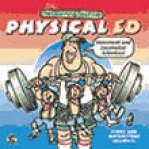
P.E. - Multiculturalism - Character Education - Test-taking strategies - Writing (How does this song make you feel? What scene would this song be a good backdrop for?)
Find multitudes of songs at http://www.songsforteaching.com
OR have students create and publish their own songs as podcasts - learn more here.
Find multitudes of songs at http://www.songsforteaching.com
OR have students create and publish their own songs as podcasts - learn more here.
Musical Intelligence
(excerpted from http://teacher.scholastic.com/products/instructor/Jan05_music.htm)
When Diane Connell taught a lesson on honeybees to third graders—including children with special needs—she looked for a way to make the subject come alive. A quick browse through the local music store turned up Rimski-Korsakov's “Flight of the Bumblebee.” Back in class, the children got out of their seats and “buzzed” around the room to the fast, jerky rhythm of the composition. “The music helped them feel exactly what I was talking about in the lesson,” says Connell, now an associate professor at Rivier College in Nashua, New Hampshire. Teaching the students in this fashion engages the emotions. “If students really care about something, they'll remember it,” asserts Connell.
As one of Howard Gardner's major intelligence areas, music is valuable for its own sake as well as for what it can add to a lesson. Linda DiPasquale-Morello, a teacher at John C. Milanesi Elementary in Buena, New Jersey, feels that music is “just as or even more important than reading, writing, and math.” She says, “Many children who do not show academic awareness or excellence have the ability to show their forte in the arts—either musical or visual art. That's why I am so against using just standardized testing for knowledge and understanding. We need all kinds of people with all kinds of talents!”
As Greg Percy, a teacher of art for 20 years in Madison, Wisconsin, has discovered, a musical intelligence can even help kids with—what else?—other types of art. Percy's greatest hits (www.songsinthekeyofart.com) include the “Picasso Polka,” “From Matisse to You,” “Michaelangelo Mad,” and “The Red and Yellow Blues”-the latter a catchy ditty on primary colors. In his art classes, Percy will show some samples of an artist's work, talk about the artist, and then play an original song pertaining to that day's art lesson. For example, his song “Van Gogh (No Stereo)” appeals to kids because they remember one gruesome fact about the Dutch master: that he cut off his ear—and, as the song goes, couldn't hear “in stereo.” The songs ignite the kids' interest and help them remember important facts and elements of art history.
“The kids are learning, but they don't know they're learning,” says Percy. “That's the best situation.
As one of Howard Gardner's major intelligence areas, music is valuable for its own sake as well as for what it can add to a lesson. Linda DiPasquale-Morello, a teacher at John C. Milanesi Elementary in Buena, New Jersey, feels that music is “just as or even more important than reading, writing, and math.” She says, “Many children who do not show academic awareness or excellence have the ability to show their forte in the arts—either musical or visual art. That's why I am so against using just standardized testing for knowledge and understanding. We need all kinds of people with all kinds of talents!”
As Greg Percy, a teacher of art for 20 years in Madison, Wisconsin, has discovered, a musical intelligence can even help kids with—what else?—other types of art. Percy's greatest hits (www.songsinthekeyofart.com) include the “Picasso Polka,” “From Matisse to You,” “Michaelangelo Mad,” and “The Red and Yellow Blues”-the latter a catchy ditty on primary colors. In his art classes, Percy will show some samples of an artist's work, talk about the artist, and then play an original song pertaining to that day's art lesson. For example, his song “Van Gogh (No Stereo)” appeals to kids because they remember one gruesome fact about the Dutch master: that he cut off his ear—and, as the song goes, couldn't hear “in stereo.” The songs ignite the kids' interest and help them remember important facts and elements of art history.
“The kids are learning, but they don't know they're learning,” says Percy. “That's the best situation.
Music for Memorization
(excerpted from http://teacher.scholastic.com/products/instructor/Jan05_music.htm)
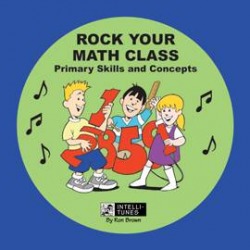
Math Set to Music
“Kids come to school knowing 'Mary Had a Little Lamb' and 'Twinkle, Twinkle, Little Star,'” says Kay Smitherman, a retired math teacher from Angleton, Texas. “Wouldn't it be nice if children came to school already knowing math formulas by heart?” Smitherman, whose “Math Songs” activities appear in the January/February issue of Instructor, has made a second career of setting math-themed lyrics to popular tunes to help kids memorize essential formulas and skills.
“With music, the steps are already implanted in your brain,” she explains. “Students can hum while a test is being taken—it's right there in their heads.” Once, she recalls, a student walked up to her after a test and confessed that a group of children had cheated. “What?” she asked, surprised. “How?” The sheepish student explained: “When we got to that part about mean, median, range, and mode, we hummed until we got to that part, then wrote it down.”
Getting students to participate in the music-making can add another level of engagement. Math educator Robyn Silbey, from Gaithersberg, Maryland, encourages the teachers she trains to “use music to help students recall basic multiplication facts, for example. The teachers challenge kids to reinforce these facts by making up new words to a well-known song.
“This strategy is an effective way to have students embed anything they need to learn for mastery or to memorize,” says Silbey. “I like it because all the kids are involved in teaching and learning, it's less work for the teacher, and it's fun and gets the job done.”
Lyrics and Language
As the self-styled Ms. Music, Beth Butler spent years visiting preschools throughout her home state of Florida, using songs to teach little ones the days of the week, parts of the body, and more. Then she made a discovery: “Using music is exactly the way to teach a new language,” she says.
A fluent Spanish speaker, Butler started Boca Beth (www.bocabeth.com), a Spanish-English language program that uses songs, movements, and puppets to teach Spanish vocabulary and phrases. The familiar songs on Butler's DVDs and CDs—such as “Five Little Monkeys Jumping on the Bed”-alternate between English and Spanish stanzas.
“Children are such sponges,” says Butler. “They pick it up quickly, and music makes it so much easier for them.” Just 10 minutes a day can put kids on the road to building a decent bilingual vocabulary—with no effort at all. Kids can just relax and listen.
While music can help kids retain a new language, it also helps them with basic skills in their native language. Christina Ledbetter, who has taught first grade for three years at Plumb Elementary in Clearwater, Florida, explains that “in the beginning of first grade, it is important for children to know that we read from left to right and then back down to the next row.” To get kids to understand this, Ledbetter uses a tune by songwriter Jack Hartmann called “The Way We Read” (www.jackhartmann.com), which kids act out with their hands and bodies as they sing along.
Children with language difficulties in particular can benefit from music, says Susan Stackhouse, a support teacher for second through fifth grade and a regular seventh- and eighth- grade classroom teacher at McDonald Elementary School in Warminster, Pennsylvania. To accommodate some of her students' disabilities, Stackhouse makes up her own lyrics to popular tunes. For example, her version of “Hokey Pokey” starts with a word like train. She sings: You take the “t” out and put a “g” in, you take the “r” out, and look at what you have.You put the sounds together and you try to sound it out. (Kids clap.) What is the new word? Kids: Gain!
“I have children self-talk through a difficult word by singing a song and applying it to their reading,” says Stackhouse. “It's very effective.”
Innovative Ways to Use New Digital Technology for Education
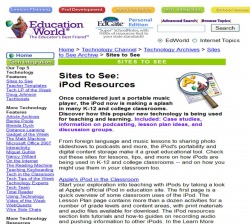
Apple has done a lot of research and development of products that can be used in education. At the following site they list ways, include utilizing lecture, file sharing, podcasting, etc. (There is also a great link to enhancing teacher professional development at the Apple site.)
For innovative ways to use new digital technology, such as creating and downloading lectures, homework, and social networking for education, check out http://www.bspcn.com/2008/02/16/100-ways-to-use-your-ipod-to-learn-and-study-better/ and http://www.education-world.com/a_tech/sites/sites070.shtml.
For innovative ways to use new digital technology, such as creating and downloading lectures, homework, and social networking for education, check out http://www.bspcn.com/2008/02/16/100-ways-to-use-your-ipod-to-learn-and-study-better/ and http://www.education-world.com/a_tech/sites/sites070.shtml.
Sites that help students create music:
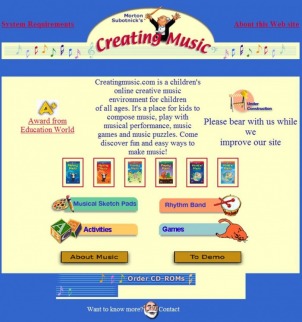
Give students the opportunity to develop musically and they may also develop mathematically, artistically, in language, and so on. The following sites are interactive, to help students understand music independently. Beneath those is a list of ways that you can become a teacher of music to your students.
http://www.creatingmusic.com
http://www.sfskids.org/templates/musicLabF.asp?pageid=11
http://www.ducksters.com/music.php
http://www.expertvillage.com/video-series/476_child-music-lesson.htm
http://gardenofpraise.com/multi.htm
http://www.teachcool.com/LearningSongs.html
Of course, one of the best ways to experience music is to make it yourself! These "ways of making music", which come from music teacher Sarah at “Real Life Blog” can also be used to teach students some music fundamentals:
http://www.creatingmusic.com
http://www.sfskids.org/templates/musicLabF.asp?pageid=11
http://www.ducksters.com/music.php
http://www.expertvillage.com/video-series/476_child-music-lesson.htm
http://gardenofpraise.com/multi.htm
http://www.teachcool.com/LearningSongs.html
Of course, one of the best ways to experience music is to make it yourself! These "ways of making music", which come from music teacher Sarah at “Real Life Blog” can also be used to teach students some music fundamentals:
- Do “sirens” with your voices, going as high and as low as possible. This teaches “pitch”. Draw waves on paper, going up and down to follow the highs and lows you produce.
- Let your child listen to CDs of other children singing. When a child only hears an adult range of notes, they sometimes fail to develop the upper range of notes that children produce so well.
- Talk about the difference between high and low and soft and loud so they learn to discriminate between them.
- Make up words to familiar melodies as you go through your day-just for fun!
- Sing or play a musical phrase and ask your child to repeat it. This develops memory and an “ear” for music.
- Create your own instruments from household items, or buy an inexpensive recorder for early success at making music.
- Do "sirens" with your voices, going as high and as low as possible. Make sure you and your child go into the "falsetto" or head voice when going high and don't try to belt it out.
- Draw waves on paper. Follow the waves with your fingers, use the siren voice to mimic the highs and lows with your voice.
- Make sure your child hears CDs of other children singing. Sometimes, when kids only listen to adults or older teens singing, they fail to develop the upper range they would need to sing with a choir, and the ability to hear and match more than a few pitches. This is especially the case with popular music, as many of the melodies have a limited range.
- Talk about the difference between high/low and loud/soft. Many kids confuse the two. For example, if you tell them to sing low, they will sing quietly. Experiment with speaking and singing low and loud, high and soft, and all other combinations.
- Make up words to familiar tunes as you go through your day. "Hi Ho the Derrio" is a good one. "We're putting on our clothes, we're putting on our clothes, Hi Ho the Derrio..."
- Sing or play a short melody, and ask your child to repeat it. Ear-training is an acquired skill, and is very important in any musical endeavor.
- "Act out" a familiar story with the piano. Take, for example, The Three Little Pigs. As the pigs are leaving home, ask, "How do think their walking would sound?" The child might play a steady beat on one key, or alternate between the two. Have them experiment until they are satisfied with the outcome. Other questions to explore are: "How would the wolf sound?" "What would the straw house sound like, as it's falling down?" "What about the bricks?"
- You could ask what clouds sound like? Rain? Snow? The possibilities are endless.
- If you don't have a piano, any household items will do: pots and pans, spoons, toy maracas or rattles, anything that makes a noise.
- Get a good quality recorder from a local music store. Recorders are usually under $10, and provide good training for other wind instruments. Young children may not be able to cover the holes and play many notes, but teach them to blow slowly and evenly until they make a pleasing sound. For older children (3rd grade or older), buy a basic recorder book, and learn with them. I directed a homeschool recorder consort (group) once, who played authentic medieval music very well. We played music to underscore a play set in a castle, and the kids were really proud of themselves.
Educational Song Databases
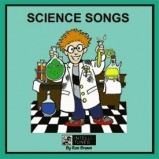
Songs for every content area for students/by teachers can be found at http://www.songsforteaching.com/
Also see http://intelli-tunes.com/educational_songs.php for individual song downloads and www.drjean.org, both are favorites of my students.
Rock n' Roll hall of Fame Lesson Plans

The Rock and Roll Hall of Fame provides excellent lesson plans to learn about the history of music and cultures. http://www.rockhall.com/teacher/sti-lesson-plans/